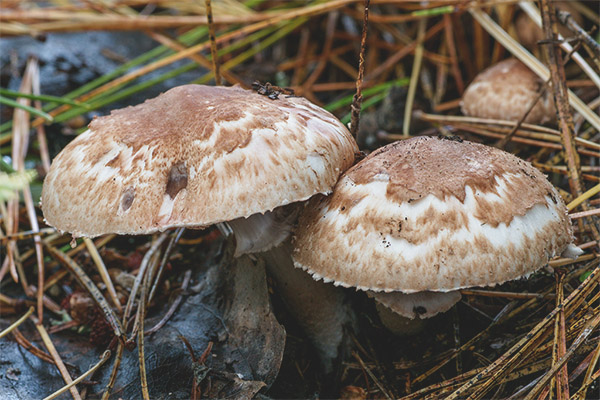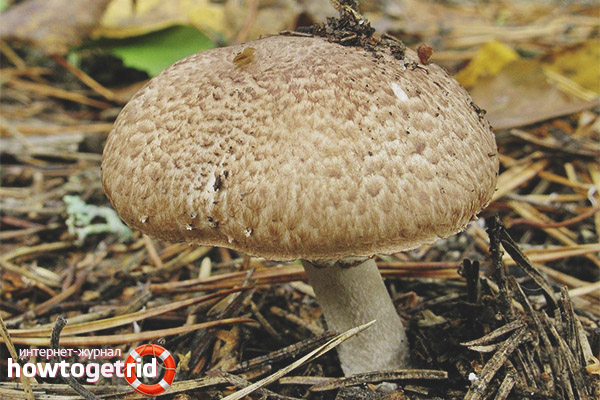The content of the article
True lovers of “quiet hunting” do not expect the onset of rainy July, when edible mushrooms of various kinds start to climb out of the ground. True mushroom pickers know that with the onset of summer (and even at the end of spring) unpretentious and tasty champignons appear. They grow everywhere - in the meadows, fields, in the forest. Forest champignon is not as common as its counterparts, is rare, so any mushroom picker will gladly cut off this tasty and nutritious mushroom.
Description
Forest champignon (another name is big champignon, popularly called a cap or grace), looks like a small round cap, under which is a long leg. In a young mushroom, a brownish-pink cap has an ovoid bell shape about 5 centimeters in diameter, expands over time, becomes flat-convex and reaches a diameter of 14-16 centimeters, while maintaining the characteristic tubercle in the center.It is covered along the radius with small scales of brownish-brown color. If you put pressure on the cap, it turns red, but immediately turns brown. The flesh is not very thick - even thin, light, when you break it, it becomes a little red, it smells good. Plate fungus, the plates are often located, at first white, becoming pink, brown, almost black with age.
The leg is in the shape of a cylinder, length is from 5 to 7 cm, diameter reaches 1.5 cm, swollen at the base, it can be even or slightly curved, at first full, as the mushroom grows older it becomes empty. Young fungi have a dirty white color; adults have a light brown color. There is a white film in the form of a hanging ringlet, which disappears with age. Spores chocolate color.
Spread
It grows in large groups, begins to bear fruit in late July and until October, and in good weather - in October.It recovers fairly quickly - a few days after harvesting, a group of mushrooms can be seen again at the same place. They are found in large numbers near anthills - apparently, the ants have learned how to use the mycelium of the fungus for their own purposes, and the champignon itself has something from these little hard workers.
How to distinguish from poisonous species?
But even among experienced mushroom pickers, there is a danger of plucking a poisonous mushroom that looks very similar to edible in all respects. There are many types of inedible champignons that have the same characteristics as the mushroom. Yes, and frankly poisonous, pale grebe and mushroom, can successfully disguise themselves as edible. How to distinguish them and not be in a mess? To distinguish between twins, you need to pay attention to some features. So, on the cap of the double in the center there is a brown speck, with which it acquires a bright yellow tinge.
There are other indicators and signs:
For example, a broken false champignon begins to smell like a pharmacy - carbolic acid or iodine, and when boiled, mushrooms, along with water, become yellow for a while. Even a long heat treatment does not relieve the product of accumulated toxic substances.
Sometimes there is confusion with other types of champignon, conditionally considered edible.One of these is the Möller mushroom, which belongs to slightly poisonous. It contains toxins that can badly affect the human body. His distinguishing features are as follows:
- The hat has a gray color, closer to the ash.
- When cut, the flesh turns brown and smells unpleasant.
- Plates on young mushrooms are light pink in color.
Often forest champignon is confused with young pale toadstool disguised under it. Recognizing it is quite simple - at the very base of the fungus there are so-called volvs (root bags) that are not noticed by many mushroom pickers. When the pulp is cracked, a bright yellow color appears on it.
Another mushroom, taken by mushroom pickers as edible, is a light fly agaric. But to recognize it is quite simple - it is worth breaking a hat, and an unpleasant, pungent smell will immediately say that the mushroom is useless.
Poisonous twins choose to grow shaded areas, hiding from the rays of the sun. Amanita grows not only under fir trees, but also in birch forests, and grebe - everywhere.
How forest mushrooms look like poisonous mushrooms
What is the difference and similarities of champignon and pale toadstool? It is worth paying attention to the details.
Similarity
First of all, the dimensions: the toadstool has the same length of the leg and the cap may also have similar sizes.
Both that and the other fungus has a ring on its leg. Only in the toadstool it disappears with time, while in the edible champignon it remains until the end of life, completely closing the bottom of the cap.
Differences
The toadstool's leg is thinner, and not so fleshy, whereas the edible twin has a thick and dense.
You also need to look at the color key of the cap. The toadstool is equally dirty white both above and below (it may be greenish with age), while the champignon has a pinkish colored lower part.
The toadstool has dense and light pulp.
It is necessary to smell the found mushroom - the champignon has a characteristic aroma, inherent in all mushrooms, slightly reminiscent of the smell of almonds. While the poisonous twin has no smell at all.
To preserve the beneficial and nutritional qualities of champignons must be properly processed. It is necessary to remove the stuck pieces of soil, remove dried or faded areas, clean out the rot from the mushrooms, cut the legs. Having done this, the mushrooms are washed and begin to cook.They make very tasty soups, they are fried, often with potatoes. Yes, and just fried mushrooms perfectly complement vegetable dishes. Also, the harvest can be dried - in winter, dried mushrooms diversify the table.
It is easy to check the safety of the harvested crop in a folk way: an ordinary onion should be thrown into a pot of mushrooms. If only normal mushrooms are cooked, nothing will happen to it, otherwise the onion will turn blue.
About the benefits and dangers of champignons
What benefits can the human body get by using champignons? It turns out great.
- There is a lot of water (more than 90%) in them, the benefits of which need not be said, a lot of human proteins, carbohydrates, organic compounds and acids, a lot of necessary vitamins (PP, B6, B12, C) and minerals, metals (iron, potassium , phosphorus, zinc). By the way, phosphorus is not less than in fish products, and there is even more vitamin B than vegetables picked from the beds.
- Because of their low calorie content, champignons find their use in various diets, while the person does not deprive himself of the necessary substances.
- Also, the use of mushrooms, not containing sugar and any fat, is useful for diabetics.
- High content of thiamine will help headache sufferers. And vitamin B5 relieves fatigue.
- In mushrooms, among other things, there are substances that act as a cholesterol destroyer, so you can and should eat them to get rid of cholesterol plaques.
- And dry mushrooms are good for those suffering from diseases of the digestive system - hepatitis and stomach ulcers.
Harm from mushrooms slightly. Besides the fact that they are easily confused with poisonous mushrooms (which was discussed above), we can note the high content of chitin - this component is difficult to digest and harm children, making it difficult to assimilate useful and necessary substances. Therefore, the child should not be given too many cooked mushrooms.
Video: forest champignon (Agaricus silvaticus)














To send